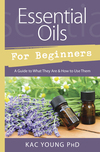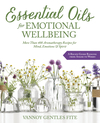Essential Oils for Well-Being

More than making a room smell nice, the use of essential oils is called aromatherapy for good reason. Because our sense of smell is intimately linked with memory and emotion, essential oils provide a way to cope with emotional issues and foster well-being. Essential oils can help reduce stress, calm anxiety, or provide a boost.
The olfactory cortex, a part of the brain that processes information about odor, is an area closely connected with the limbic (emotional/visceral) system. Details about what we smell is collected through thousands of olfactory receptors located in a small area at the top of each nasal cavity. As we inhale, air passes over these receptors and data is carried along a nerve pathway into the brain. In addition to interpreting information, our sense of smell influences the functioning of the central nervous system. This is why aromatherapy is so powerful: scent affects the brain's activity. Scent can help us deal with a range of emotions, alter moods, and help focus attention. Scent also enhances the ambience of a room, making us feel relaxed, energized, or uplifted.
The easiest way to use essential oils to support emotional health and well-being is to diffuse them into the air. There are various types of diffusers; some are high-tech gadgets, but reed diffusers and scented candles are gentle methods that are equally effective. And, because our noses are constantly bombarded by so many scented products, a subtle approach is a welcomed change.
Reed Diffusers
This method takes a little longer to disperse essential oils into the air than its electronic counterparts, but it's worth it—especially if you want to use scent in your bedroom. Safe and silent, it continues to work all night. A reed diffuser is also easy to make.
Items for making a reed diffuser:
- A decorative glass or porcelain container;
- Reeds;
- Carrier oil;
- Essential oil or blend.
A short glass or porcelain jar or a vase with a narrow neck works best. Do not use a plastic container, because chemicals from the plastic can leach into the oils. A wide-mouth jar with a cork can be adjusted by drilling a hole in the cork so that it is large enough to accommodate the reeds. Although there are several types of reeds on the market, rattan work best because they are porous and wick the oils more evenly. Reeds should be at least twice the height of the jar or vase.
A lightweight carrier oil works best for the base oil because it is drawn up through the reeds more easily than a thick oil. While sweet almond is often recommended for the base, I have found that sunflower, being a very thin oil, works especially well. If you are using more than one essential oil, mix them together first, and then give the blend about a week for the fragrance to develop and mature.
Pour ¼ cup of carrier oil into your diffuser jar or vase, add 2 teaspoons of essential oil or blend, and then gently swirl to mix. Adjust the amounts for a larger or small container. Place the reeds in the jar. Turn the reeds upside down a couple of times the first day or two to get them started. After that, turn them once a day or every other day to disperse the scent. Over time, you may need to add more carrier and essential oils to the jar. Replace the reeds when they become completely saturated, because they will no longer draw up fresh oil.
There are several things to avoid when making a reed diffuser. First, the fragrance oils on the market for reed diffusers are usually synthetic and not essential oils. Some of them may smell nice, but they are made from chemicals. The commercial base oils for reed diffusers are often chemical-based, too. Mineral oil and dipropylene glycol are sometimes recommended for a base oil, but avoid these for the same reason.
Scented Candles
Until you make your own scented candles, it may appear to be a complicated project, but it's not. I like making tealight candles because they are quick and easy to make. Tealight cups are available at most craft stores and online. If you're thinking of making a larger candle, a mason jar or decorative glass container can be used. Be sure it is safe to hold hot liquid.
Items for making tealight candles:
- Tealight cups;
- Glass measuring cup;
- Saucepan large enough to hold the measuring cup;
- Knife for stirring wax;
- Wax;
- Coconut oil (when using beeswax);
- Essential oil or blend;
- Carrier oil to give scent staying power;
- Wicks.
The base ingredient for candles is, of course, wax, and there are four commonly-used types: paraffin, palm, soy, and beeswax.
Paraffin is a petroleum byproduct and not a good choice for aromatherapy or other practices for well-being.
Palm oil has become controversial. It has been overused in food, beauty products, detergents, animal feed, and biofuel, and is now regarded as a major contributor to rain-forest deforestation.
Soy wax is easy to work with and clean up. However, a point to consider is that most of the soybean crop is genetically modified and may contain pesticides; you will need to do research to avoid GMOs. The terms "pure" and "100% pure" on the label only mean that the soy was not mixed with any other type of wax (such as paraffin).
Beeswax has been used for making candles since ancient times. While it is a little more expensive, it is a natural product that is especially good if you have allergies because it improves the air by neutralizing dust and odors. When purchasing beeswax, look for filtered cosmetic quality. Unfiltered wax contains some pollen, honey, and debris from the hive. Filtered wax doesn't contain these things and has less of an aroma that doesn't usually interfere with the scent of essential oils. Filtering also makes the wax blend more easily and evenly with other substances, such as carrier oils. When used for candles, filtered beeswax burns more evenly and produces less smoke than other types of wax.
While beeswax starts out white, it picks up color from pollen and ends up anywhere from pale amber to yellow to butterscotch brown. Like honey, the color depends on the types of flowers the bees foraged. Further filtering can produce a whiter beeswax, but bleaching with chemicals is often done to present a pristine appearance. Check carefully before buying white beeswax. As with soy, it can be mixed with other waxes, so look for the terms "pure" or "100% pure" on the label.
Soy wax is sold in blocks and flakes; beeswax is sold in blocks, bars, and pellets (also called pastilles, pearls, and beads). Blocks of wax can be grated like cheese, making it easy to measure and melt. Beeswax pellets are convenient and easy to use but can be pricey. I find it economical to buy beeswax in one-ounce bars, which is equal to two tablespoons. To measure smaller amounts, cut the bar in half or in half again. To make it easier to cut, place the bar in a plastic bag and set it in a bowl of hot tap water for about ten to fifteen minutes. When you are ready to make candles, chop the beeswax into smaller pieces so it will melt faster.
Candle wicks have small metal tabs at one end that go in the bottom of the jar or cup. While tealight candle wicks are easy to deal with, keeping a wick centered in a jar for a larger candle can be a little tricky. To help, place a clip style clothespin on its side across the top of the jar and thread the wick up through the spring. Wrapping the top of the wick around a pencil or barbeque skewer also works to keep it in place. If you are using beeswax, dip the tab in the melted wax and stick it to the bottom of the container to help keep it anchored. (Note that this doesn't work with soy.)
The amount of wax and essential oil in the following recipe is a basic guideline and depends on the type of wax used. When using beeswax, mix approximately three parts beeswax to one part coconut oil, which will help it solidify more evenly. When using a blend of essential oils, mix them together first and give them about a week for the fragrance to mature. The amount of essential oil or blend depends on the strength of the oils you use.
As an alternative to tealight cups, use a mini-cupcake pan for your candle molds. Take notes while making candles so you will know how you might want to adjust the amounts of oils and wax the next time you make them. The following recipe makes three to four tealight candles.
Tealight Candle Recipe
- 1 ounce wax
- 2 teaspoons coconut oil (if using beeswax)
- 2 teaspoons essential oil or blend
To make the candles, place a glass measuring cup with the wax and coconut oil (if using beeswax) in a saucepan of water and warm over low heat. Stir continually until the wax melts, and then remove it from the heat. If you are using beeswax, when it has melted dip the bottom of the wick tab in the wax and set it in the bottom of the jar or tealight cup.
Allow the mixture to cool slightly. While it is still liquid, mix in the essential oil. You may need to set the measuring cup in the pan of hot water for a minute if the essential oil congeals in the wax. Pour the wax into the jar or tealight cups but keep a little aside. As the wax cools, it may sink slightly in the middle around the wick. It may also crack or pull away from the sides of the container. Warm the leftover wax and add it to the jar or tealight cup to fill in these spaces. When the wax is cool, trim the wicks and give the candles a couple of days to set before using them.
Essential Oils for Well-being
- For General Well-Being: Anise seed, bergamot, caraway seed, clove bud, coriander, eucalyptus, geranium, ginger, grapefruit, juniper berry, lavender, lemon, lime, mandarin, manuka, marjoram, myrrh, neroli, orange, petitgrain, pine, rose, ravintsara, rosemary, sandalwood, thyme
- To Calm Nervous Tension: Angelica, basil, bergamot, cardamom, cedarwood, chamomile, clary sage, cypress, elemi, fir needle, frankincense, geranium, grapefruit, hyssop, juniper berry, lavender, lemon balm, mandarin, marjoram, neroli, orange, palmarosa, petitgrain, pine, ravintsara, rose, sage, spearmint, vetiver, ylang-ylang
- For Mental Focus and Clarity: Ayris, basil, bay laurel, bergamot, black pepper, cajeput, cardamom, cedarwood, cinnamon leaf, citronella, clary sage, cypress, elemi, eucalyptus (lemon), frankincense, geranium, grapefruit, helichrysum, lavender, lemon, lemon balm, lemongrass, manuka, myrrh, neroli, niaouli, orange, palmarosa, patchouli, peppermint, petitgrain, pine, ravintsara, rosemary, sage, spearmint, tea tree
- For Peace and Tranquility: Amyris, angelica, basil, bay laurel, bergamot, cedarwood, chamomile, clary sage, coriander, cypress, fir needle, geranium, ginger, helichrysum, lavender, lemon balm, marjoram, myrrh, neroli, orange, palmarosa, patchouli, pine, rose, sandalwood, ylang-ylang

About Sandra Kynes
Related Products



is subject to certain Terms and Conditions